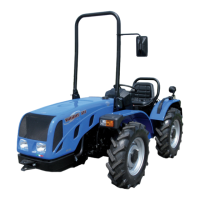G
B
I
SHAFT FORMS A HIGH ANGLE WITH
THE PTO.
The control lever (31, fig. 6.5) is used to lower
or raise the lift arms.
– Move the lever forward to raise the lift arms.
– When the lever is in its home position, the lift
arms do not move.
– Move the lever back to lower the lift arms.
The lever can be held in the lowest posi-
tion by pushing down on it and the lift
arms will be in their free floating position.
The “suspension” function is achieved with the
flow switching lever (33.1, fig. 6.8) at the left of
the operator (with the tractor in the rear facing
position) under the hydraulic control valves.
– If the flow switching lever (33.1) is moved to-
wards the gearbox (pos. b) you have the “su-
spension” effect.
In this function, one cylinder works in combina-
tion with the accumulator and the other is used
for lift functions.
– Lever (33.2) connected to the hydraulic con-
trol valve, operates arm raising or lowering.
– Lever (33.3) is used to charge or relieve the
accumulator to the required pressure (based on
CARDANO ACCENTUATE È NECES-
SARIO UTILIZZARE CARDANI CON
GIUNTI OMOCINETICI.
La leva di comando (31, fig. 6.5) consente di ab-
bassare o sollevare i bracci del sollevatore.
– Il sollevamento dei bracci si ottiene spostan-
do la leva verso l’alto.
– Con leva in posizione di riposo i bracci sono
fermi.
– L’abbassamento dei bracci si ottiene spostan-
do la leva verso il basso.
È possibile agganciare nella posizione più
bassa la leva, premendo sulla stessa, otte-
nendo la libera escursione dei bracci (flot-
tante).
La funzione “sospensione” si ottiene agendo
sulla leva del deviatore di flusso (33.1, fig. 6.8).
– Posizionando la leva del deviatore di flusso
(33.1) verso la scatola cambio (pos. “b“) si ottie-
ne la funzione “sospensione”; in questo modo
un martinetto funziona in abbinamento con l’ac-
cumulatore e l’altro viene utilizzato per il solleva-
mento.
– La leva (33.2), collegata al distributore, co-
manda il sollevamento e l’abbassamento dei
bracci.
SHAFT FORMS A HIGH ANGLE WITH
THE PTO.
The control lever (31, fig. 6.5) is used to lower
or raise the lift arms.
– Move the lever forward to raise the lift arms.
– When the lever is in its home position, the lift
arms do not move.
– Move the lever back to lower the lift arms.
The lever can be held in the lowest posi-
tion by pushing down on it and the lift
arms will be in their free floating position.
The “suspension” function is achieved with the
flow switching lever (33.1, fig. 6.8) at the left of
the operator (with the tractor in the rear facing
position) under the hydraulic control valves.
– If the flow switching lever (33.1) is moved to-
wards the gearbox (pos. b) you have the “su-
spension” effect.
In this function, one cylinder works in combina-
tion with the accumulator and the other is used
for lift functions.
– Lever (33.2) connected to the hydraulic con-
trol valve, operates arm raising or lowering.
– Lever (33.3) is used to charge or relieve the
accumulator to the required pressure (based on
CARDANO ACCENTUATE È NECES-
SARIO UTILIZZARE CARDANI CON
GIUNTI OMOCINETICI.
La leva di comando (31, fig. 6.5) consente di ab-
bassare o sollevare i bracci del sollevatore.
– Il sollevamento dei bracci si ottiene spostan-
do la leva verso l’alto.
– Con leva in posizione di riposo i bracci sono
fermi.
– L’abbassamento dei bracci si ottiene spostan-
do la leva verso il basso.
È possibile agganciare nella posizione più
bassa la leva, premendo sulla stessa, otte-
nendo la libera escursione dei bracci (flot-
tante).
La funzione “sospensione” si ottiene agendo
sulla leva del deviatore di flusso (33.1, fig. 6.8).
– Posizionando la leva del deviatore di flusso
(33.1) verso la scatola cambio (pos. “b“) si ottie-
ne la funzione “sospensione”; in questo modo
un martinetto funziona in abbinamento con l’ac-
cumulatore e l’altro viene utilizzato per il solleva-
mento.
– La leva (33.2), collegata al distributore, co-
manda il sollevamento e l’abbassamento dei
bracci.
G
B
I
108

